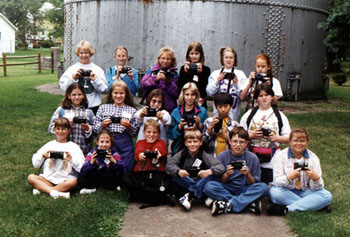
|
      

|
Making
prints, La Crosse, Wisconsin
I am equal parts photographer
and nonfiction writer, and I find greatest reward in the application of
both arts to the task of illuminating some idea, some place, some story,
some part of American life.
For me, photography is best employed in the study of something, a fragment
of the glorious, palpable, sensory world. Unlike any other art--opera,
painting, fiction, etc.--photography has the power to reveal distant things
and events in a concrete, specific way. When my work is at its best, there
is no need for suspension of disbelief; every tiny thing within the image
is clear, unmanipulated, in focus, specific, and invites the close attention
of the viewer. Opera distills emotion to its purest form; painting makes
visible that which cannot otherwise be seen; fiction plumbs the breadth
of human existence; and photography, for me, makes the world real.
Because of my writer's sensibilities, I find it important to know a great
deal about the subjects I photograph. For example, I think my images of
grain elevators are better because I know how grain elevators are built
and how they work. Landscape photographs are better for having some understanding
of basic geologic processes. Like any photographer, I respond first visually
to any subject; but by bringing to bear some deeper knowledge of a subject
means I can probe it more thoroughly and reveal it more intimately, rather
than respond only to its evident surface qualities.
Since almost all of my photographs are "found" rather than "planned,"
there is no substitute for simply being there with the tripod set up when
the subject and the light are right, so my methods of travel and photographing
are devised to provide greatest access to potential subjects.
Put more simply, I sleep in the truck a lot, or camp. This means I can
photograph late into the evening, until the light fails altogether, then
make a meal by lantern light over the camp stove, sleep where I am, wake
with the morning light, and begin shooting again as soon as my eyes are
open enough to focus. A look at my contact sheets reveals a number of
subjects photographed in light from opposite directions: first in the
low slanting light of evening and then in the low slanting light of the
next morning.

|
|
Fourth grade photographers from Marshfield, Wisconsin, slow down long
enough to have their portrait taken. These energetic photographers
were the core of Hokanson's photo workshop called "Photographing Your
Town," sponsored in conjunction with the exhibit of "Photographs of
a Small Place" at the New Visions Gallery, Marshfield, Wisconsin in
1994. |
I've not worked alone
on these book and exhibit projects. My wife, Carol Kratz, gets a lot of
reading done when she accompanies me and is happy to talk to the curious
rancher who stops to see what's going on, leaving me to concentrate on
getting the shot before the clouds move and the shadows change. Because
of our close and ongoing collaboration (she edited my first two books),
we've embarked on a couple of book projects together as coauthors. See
the Books
& Publications page for details.
Geographers, historians, and other peripatetic wanders like myself have
filled my maps with good places to check out, and numerous local residents
have taken me (or us) to remote sod houses, ghost towns, the back forty,
have fed us and put us up for the night.
Some technical stuff:
My equipment and film choices are based on the idea of often spending
long weeks in the field immersed in subjects and shooting a lot of film.
The black and white photographs on this site were made with either Hasselblad
equipment (2 ¼ inch square negatives) using lenses from 50mm to 250mm,
or with a Fuji G617 panorama camera (2 ¼ by 7 inch negatives) with its105mm
lens. Since I sometimes return home from a three-week shooting trip with
a cooler containing as much as 140 rolls of exposed film, the cumbersome
nature of sheet film would make these sorts of field trips impractical.
I shoot on Kodak T-Max 100 and 400 film, process it in D:76, and for exposure
and development, I use Ansel Adams' version of the Zone System right out
of his wonderful book, The Negative.
In my field notes I record film information relevant to development for
each roll but don't bother with aperture and shutter speed.
Back in the darkroom, I print on Oriental Seagull VC fiber paper using
a great old Bessler enlarger with a colorhead and on a highly modified
Zone VI enlarger. My prints are selenium toned and processed to archival
standards. And I work in 35mm and in color. Purebred and Home-Grown:
America's County Fairs has all been shot on Kodachrome 200 transparency
film.
|

